ТОП просматриваемых книг сайта:
William Bradford Huie
Список книг автора William Bradford HuieАннотация
In this rousing sequel to his classic Can Do! The Story of the Seabees, William Bradford Huie continues the saga of the combat trained civilian plumbers, carpenters, heavy equipment operators, wharf builders, and civil engineers who served in the U.S. Navy construction battalions. The story begins in 1944 with the battle for Iwo Jima when the Seabees braved concentrated enemy fire and Iwo's daunting terrain to rig floating causeways, blow up wrecked landing craft, and drive their bulldozers up three terraces that rose from the ocean to secure the beachhead. This book fully chronicles their heroism, including the unforgettable efforts of the men of the 31st Battalion who crawled the length of a landing strip to pick up shrapnel as Japanese snipers fired away.Huie does equal justice to the historic actions of the Seabees on D-Day at Omaha Beach, where they manned fifteen hundred vehicles during the first wave of landings at Normandy. He provides fascinating accounts of the creation and testing of various pierheads, floating steel bridges, and «Rhino» ferries. His narrative of Seabee accomplishments is heavily laced with colorful stories of moonshining, brawling, and carousing juxtaposed with compassionate stories of the children in the prisoner of war camps. His enthusiasm for the Seabees gained instant acceptance when this book was first published in 1945 and is often cited as inspiring succeeding generations to rise to the same spirit of devotion and loyalty to their task.
Аннотация
When William Bradford Huie, a reporter for H. L. Mencken's American Mercury, joined the U.S. Navy in 1943, he received a commission as a public relations officer in the little-known Civil Engineer's Corps Construction Battalions–the Seabees. With the publication of Can Do! the following year, Americans soon came to appreciate the significance of the corps's work and the danger of their wartime activities. As readable and entertaining today as it was some fifty years ago, this account tells the story of the Seabees who landed with the Marines at Guadalcanal and Wake Island, Sicily and Salerno. Experienced civilian engineers, carpenters, steam-shovel operators, plumbers, truck drivers, surveyors, and the like, they landed with the first waves of American assault troops, bringing heavy equipment ashore to build roads, bridges, and airfields and repair whatever they could. Often working under enemy fire, they incurred many casualties and won the deep respect of everyone who came into contact with them.Huie's book is filled with spirited accounts of the Seabees's achievements in the Aleutians, the South Sea islands, Europe, and Africa. A passionate and convincing advocate, Huie wrote the book not only to call attention to their accomplishments but to serve as an inspiration to others, and he often has the Seabees tell their stories in their own words. Appendixes offer valuable details, including lists of casualties, award recipients, and Seabees' poems. An introduction by Donald R. Noble is included in this new paperback edition.


